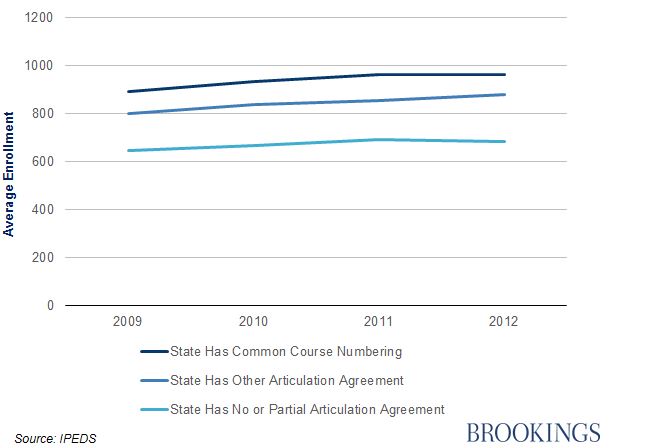In January, President Barack Obama announced his plan to make two years of community college free for students. Clearly, the goal of the policy is to increase the educational attainment of Americans by reducing the initial cost of enrollment for many people.
However, one possible unanticipated outcome of this policy could be that some students, who would otherwise have enrolled in a four-year institution, would choose to enroll in a community college instead in order to take advantage of the subsidy. This may negatively impact some students if outcomes are worse for those who begin at two-year rather than four-year colleges, as some research suggests is the case. In particular, though many students enter community colleges stating that they intend to transfer to a four-year university and earn a Bachelor’s degree, only approximately 20 percent ever do.
The path to transfer for community college students is complex. In a 2011 paper, Judith Scott-Clayton evocatively described finding the way to degree completion at community college as “the equivalent of navigating a shapeless river on a dark night.” Recognizing that the process of transferring from a two-year to a four-year college is complex, several states have mandated that public colleges and universities adopt transfer and articulation agreements. These agreements take different forms but all attempt to clarify or streamline the pathway to transfer by guaranteeing that taking certain courses or pursuing particular degrees will allow students who begin at two-year institutions to transfer the credits they earn. Perhaps surprisingly, a handful of studies that compared transfer rates in states with transfer and articulation agreements to those in states without them found no impact of these policies.
However, these studies have ignored the diversity across states’ articulation agreements. For example, some states have tried to increase transfer rates by developing common course numbering systems, while others have developed agreements that guarantee the transfer of particular course credits or sets of courses. Increasingly over the past several years, states have adopted policies that guarantee transfer with junior status to community college students who complete their associate degree before transferring.
Table 1 summarizes state transfer and articulation agreements as of April 2014.
Table 1: States with articulation agreements

Source: Education Commission of States
Policies that guarantee transfer for students who complete a common core of courses or an associate degree do very little to address the complexity and lack of structure that plague community colleges. The one form of articulation agreement that does anything to simplify the pathway between public two-year colleges and four-years is common course numbering. A student enrolled in a system with common course numbering can compare his or her course plan at the community college with the degree requirements at their target four-year institution, without the additional complexity of trying to determine which courses are equivalent. Therefore it seems plausible that students enrolled in states with common course numbering policies may be more likely to transfer than those in other states.
Since 2009, the Integrated Postsecondary Data System (IPEDS) has included a variable for students who transferred in from another institution. Figure 1 compares the average fall enrollment of transfer students[1] at public four-year institutions in states with common course numbering, other types of articulation agreements, and no widespread articulation agreements.
Figure 1: Fall enrollment of transfer students

The differences in levels displayed in Figure 1 suggest that common course numbering may increase transfer rates. Moreover, if I use a simple model to control for county characteristics that may affect these enrollment trends, including population size, unemployment rate, college-age population, and percent of the population living in poverty, I find public four-year institutions located in states with a common course numbering policy have, on average, 199 more transfer students enrolling than institutions in states with other types of articulation agreements.
This simple comparison has its weaknesses, however. First, IPEDS data do not differentiate between students who have transferred from a two-year college and students who have transferred from another four-year college. Though four-year institutions in states with common course numbering appear to enroll more transfer students on average than institutions in states with other types of articulation agreements, I can’t eliminate the possibility that these transfers are students coming from other four-year institutions, rather than from community colleges. Second, this analysis is not causal. There may be other differences between these states (for example, other policies in effect, or differences in overall rates of college-going) that I did not control for, but which affect the enrollment of transfer students. Finally, I am unable to say how different types of articulation agreements affect the transfer rates of students who enter community college with the goal of transferring. Unfortunately this institution-level dataset does not allow me to identify students’ educational goals.
Common course numbering is a system-wide, structural change that may affect rates of transfer from two-year to four-year colleges. However, this policy in no way addresses all of the barriers facing students entering community colleges with the intention of transferring to a four-year institution. Some institutions and community college systems are implementing more comprehensive approaches to increasing transfer rates, however. For example, in 2009, Arizona State University (ASU) began to offer a promising set of tools designed to promote vertical transfer between Arizona community colleges and ASU. For a target set of majors, the tools provide students who intend to transfer with clear pathways indicating the courses they will need to take as well as the sequence in which they need to take them. More recently, these tools have been further developed to help students track their progress through these pathways. Though tools like these have not yet been evaluated causally, there is some evidence suggesting that they may increase transfer rates.
Reducing the cost of community college will only increase educational attainment if coupled with policies that improve student outcomes such as persistence, degree completion, and transfer. Policies that address the problems of complexity and lack of structure at community colleges have clear potential to improve student outcomes.
[1] Transfer students are defined as degree-seeking students entering the institution for the first time having been previously enrolled in another institution at the same level (i.e. undergraduate or graduate). Undergraduate enrollment is defined as enrollment in a certificate, associate or Bachelor’s degree program.
The Brookings Institution is committed to quality, independence, and impact.
We are supported by a diverse array of funders. In line with our values and policies, each Brookings publication represents the sole views of its author(s).




